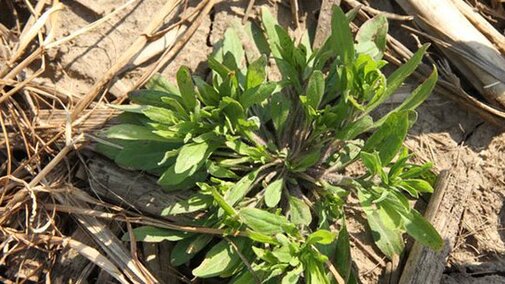Weed Season Begins: Top Spring Weeds to Watch in 2018
Nebraska Extension Weed Scientist Greg Kruger is one of several quoted in this DTN/Progressive Farmer article on the importance of early season weed control. "Start clean; stay clean," Kruger says. "Getting out there at least 30 days before planting opens up your options in terms of chemistry you can use and lets you get good chemistry rotation in your burndown." Read more on how marestail, kochia, and ragweed — and the herbicide resistance they bring — complicate spring weed control.
The Good and Bad of Cover Crop Insects
Justin McMechan, Nebraska Extension crop protection and cropping systems specialist, discusses observations of wheat stem maggot damage in early-season corn planted directly into wheat or rye cover crops in central and eastern Nebraska in Nebraska Farmer this week. "In each of the cases, corn had been planted directly into a living cover crop before the cover had been terminated, with termination occurring one to 13 days after planting," writes Curt Arens. "In some cases, where only small portions of a field had been planted into a cover for erosion control, damaged corn plants from WSM were confined to within a few feet of where the cover crop had been growing during planting time." University researchers will be studying WSM populations in cover crops this spring and testing different grass hosts to check their susceptibility to WSM. McMechan does not recommend automatically spraying insecticides when terminating a cover crop. Read more
Improved Use Efficiency of Applied Organic Nitrogen
Land application of organic materials for soil management in Nebraska is important. The availability of applied organic N and the fertilizer N substitution values of applied organic materials are not well predicted, note three IANR researchers in an article in this month's Nebraska Water Newsletter. The uncertainty of applied organic N availability leads to over-application of fertilizer N resulting in low efficiency of applied N use. Research has been done to validate or adapt canopy sensor guided in-season N application practices for fields with manure or other organic material applied, and to improve the prediction of the fertilizer N substitution values for organic materials.
Read More of the article by Charles Shapiro, former extension soils specialist, Charles Wortmann, extension soils specialist; and Tim Shaver, extension nutrient management specialist, at Water.unl.edu, where you can also subscribe to the Water Column newsletter.
A Closer Look at Managing Wheat Under Irrigation
Extension Educator Jenny Rees is quoted in a recent Nebraska Farmer article looking at irrigated wheat production in Nebraska. She describes how the challenges in eastern Nebraska differ from those in the west, noting disease and fungicide applications are almost always a factor for eastern growers. “They should plan to irrigate the field during the boot stage and before heads emerge if moisture is lacking in the soil profile,” Rees says. “You want to make sure you have enough water in the soil profile through the pollination period, and to plan not to do any watering during pollination.” No-till farmer Mark Watson of Alliance describes why using the right crop rotation is critical to success in western Nebraska. “We had always planted wheat following edible beans,” Watson says. “We usually planted the wheat past the optimal planting date in the fall because of bean harvest, so that put our wheat at a disadvantage.” Now Watson plants yellow field peas prior to wheat. Read more.
Nebraska Extension Water Resources Engineer Wayne Woldt is quoted in a Nebraska Farmer article looking at the use of unmanned aerial systems (UAS), also called drones, on the farm. "There are still a lot of unresolved questions about agronomic applications," Woldt said, as he described the issues before legislators and users. Woldt estimates that eventually about 70% of the UAS market will focus on agricultural applications. Read more.

